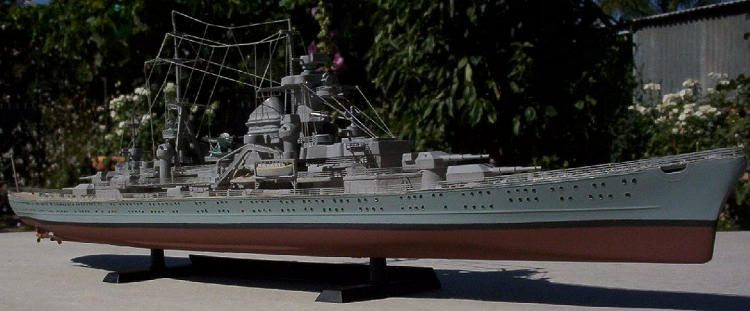
Revell 1/720 DKM Prinz Eugen
| KIT #: | 05050 |
| PRICE: | £6.99 from KingKit |
| DECALS: | Custom made for Ar 196 |
| REVIEWER: | Steven S Pietrobon |
| NOTES: | WEM 1/700 Admiral Hipper Class PE744 and 3-Bar Rails PE714 |

| HISTORY |
DKM Prinze Eugen was a WWII German heavy cruiser with eight
8" guns and twelve 4.1" guns. For a history of the ship, I will repeat one of
the best descriptions I have ever read, that from my 1967 Revell GB
instructions.
"THE PRINZ - ROYAL MEMBER OF A SMALL FAMILY A shortcoming of the German war
machine in World War II was its lack of a powerful surface navy. However, the
small number of major vessels that composed the German surface fleet were
inferior to none. Among these was the heavy cruiser Prinz Eugen, one of the few
large German ships to survive the war. She entered service in August, 1940,
taking her training cruises in the Baltic Sea. Her first combat voyage began May
18, 1941, when she accompanied the superdreadnaught Bismarck on her fateful
journey into the Atlantic.
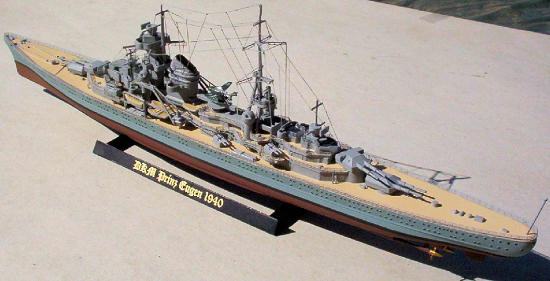 BRITAIN'S
HOOD A VICTIM OF PRINZ EUGEN'S GUNS As the two German warships steamed through
the Denmark Straits between Greenland and Iceland they were intercepted by two
British cruisers. These were soon joined by the battleship Prince of Wales and
the cruiser Hood. In the ensuing battle the heavy armament of Prinz Eugen proved
its worth as a well placed salvo of 8 inch shells shattered Hood. A second round
from Bismarck, minutes later, completed the destruction of the British cruiser.
BRITAIN'S
HOOD A VICTIM OF PRINZ EUGEN'S GUNS As the two German warships steamed through
the Denmark Straits between Greenland and Iceland they were intercepted by two
British cruisers. These were soon joined by the battleship Prince of Wales and
the cruiser Hood. In the ensuing battle the heavy armament of Prinz Eugen proved
its worth as a well placed salvo of 8 inch shells shattered Hood. A second round
from Bismarck, minutes later, completed the destruction of the British cruiser.
For a brief period following the loss of the British ship the Germans evaded
their enemies. In spite of very poor weather, a determined British force of
planes and ships relocated the fleeing Germans and attacked again. Bismarck,
suffering some damage from the previous assault, was forced to counterattack,
and her captain ordered the Prinz to retreat southward to France. The huge
German battleship then faced alone the superior British forces that finally
bested and sank the famous Bismarck.
THE CHANNEL DASH On February 11, 1942, after a nine month layover at Brest,
France, Prinz Eugen again attracted world wide attention. Slipping under the
very noses of the British Blockade at Brest, the Prinz led the battlecruisers
Scharnhorst and Gneisenau in a suspenseful run up the channel in a bid for
freedom. Although the British fleet was successfully eluded, both of the
battlecruisers were severely damaged by mines. A few days after the channel
breakthrough, the Prinz safely escorted the pocket battleship Admiral Scheer
north to Norway.
S TERNLESS -
BUT STILL AFLOAT Less than two weeks later, on Feb. 23, the captain of the
British submarine Trident watched quietly as the Prinz cruised down
Trondheimsfjord, heading back to the Atlantic. The serenity of the fjord was
suddenly shattered as one of Trident's torpedoes tore into the aft section of
the German cruiser. The entire stern of the Prinz broke away as a result of the
explosion. Only the quick action of her crew and the remarkable strength of the
vessel kept her afloat. By mid May of 1943, Prinz Eugen was back in service.
Following artillery training in the Baltic, the Prinz saw action against Russian
coastal targets until the war's end.
TERNLESS -
BUT STILL AFLOAT Less than two weeks later, on Feb. 23, the captain of the
British submarine Trident watched quietly as the Prinz cruised down
Trondheimsfjord, heading back to the Atlantic. The serenity of the fjord was
suddenly shattered as one of Trident's torpedoes tore into the aft section of
the German cruiser. The entire stern of the Prinz broke away as a result of the
explosion. Only the quick action of her crew and the remarkable strength of the
vessel kept her afloat. By mid May of 1943, Prinz Eugen was back in service.
Following artillery training in the Baltic, the Prinz saw action against Russian
coastal targets until the war's end.
A PEACETIME SACRIFICE The Prinz was surrendered to the allies in May, 1945, at
Copenhagen, Denmark. She joined the U.S. Navy for a brief period, then on June
17, 1946, she reported for her final duty. Anchored at Bikini Atoll in the South
Pacific, the Prinz became the target for the devastating atomic bomb tests. On
November 15, 1947, her hull battered by the force of many infernos, Prinz Eugen
sank into the depths of the Pacific Ocean."
| THE KIT |
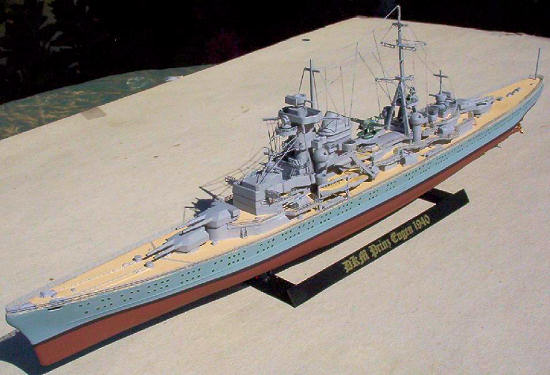 I first
built this kit around the mid 1970's. The boxing was by Revell GB, kit number
H-481, and with a copyright date of 1967. As with all my models at that time, I
built it straight out of the box without any paint. All I can remember was how
poor the kit was in comparison to the Airfix 1/600 kits I had built, which put
me off kits in 1/700 scale or smaller.
I first
built this kit around the mid 1970's. The boxing was by Revell GB, kit number
H-481, and with a copyright date of 1967. As with all my models at that time, I
built it straight out of the box without any paint. All I can remember was how
poor the kit was in comparison to the Airfix 1/600 kits I had built, which put
me off kits in 1/700 scale or smaller.
This build is of the Revell GMBH reissue in 1991, made in
Poland. However, the parts did not look as bad as I remember them, with quite
good detailing on the guns. There are 70 parts in the kit, with 6 additional
parts to build the sister ship DKM Blücher. I got my kit from KingKit for £5.99
in 2004. You can build the kit either as a waterline or as full hull which is my
preference.
The guns are moulded with the turrets in a fixed horizontal orientation. As
expected with a mould of this age, there were a small number of sink marks,
flash and imperfections. All are easily fixed with some sandpaper, putty and
plastic card.
| COLORS & MARKINGS |
To detail the model, I used the White Ensign Models photo-etch detail set, designed for the 1/700 Tamiya kit. I found all the parts fitted the slightly smaller Revell kit without any problem. I also used WEM paints, Hellgrau 50 KM01, Dunkelgrau 51 KM02, Schiffsbodenfarbe III KM04, Dunkelgrau 2 KM06 and Teak C01. This matched the 1940 time frame I was modelling the kit on.
| CONSTRUCTION |
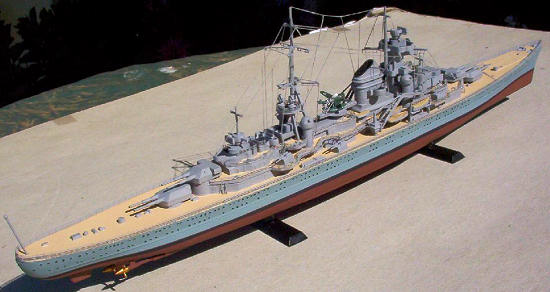 After
painting the guns in Hellgrau 50, these were masked and then attached to the
deck. The deck and hull parts were then assembled, followed by the propeller
shafts and middle propeller. The upper half of the hull was first sprayed in
Dunkelgrau 51. The portholes were then carefully painted using a 000 brush and
gloss black paint. After drying, this was masked and the lower hull sprayed in
Schiffsbodenfarbe III. This again was masked and the waterline painted in matt
black. The waterline was then masked, so that I could handle the model while
building up the superstructure. The deck was sprayed with Teak, with detailed
sections brush painted with Hellgrau 50, which is used for all the
superstructure. Steel decks were painted in Dunkelgrau 2, which is almost black
in colour.
After
painting the guns in Hellgrau 50, these were masked and then attached to the
deck. The deck and hull parts were then assembled, followed by the propeller
shafts and middle propeller. The upper half of the hull was first sprayed in
Dunkelgrau 51. The portholes were then carefully painted using a 000 brush and
gloss black paint. After drying, this was masked and the lower hull sprayed in
Schiffsbodenfarbe III. This again was masked and the waterline painted in matt
black. The waterline was then masked, so that I could handle the model while
building up the superstructure. The deck was sprayed with Teak, with detailed
sections brush painted with Hellgrau 50, which is used for all the
superstructure. Steel decks were painted in Dunkelgrau 2, which is almost black
in colour.
The superstructure and detail parts were gradually added, brush painting as I
went. I prefer not to use washes, as I think washes gives a very ugly and
unrealistic finish. For the bridge, there are some walls that I added using
plastic card. The wings were also cut off and replaced with WEM PE replacements.
For the Arado Ar 196 floatplane, the Revell parts needed
quite a bit of cleanup and some repair. I printed my own decals using my ALPS
printer, scaled down from the 1/72 decals in the Airfix kit! The pontoons had to
be cut out off from the plastic launch rail,
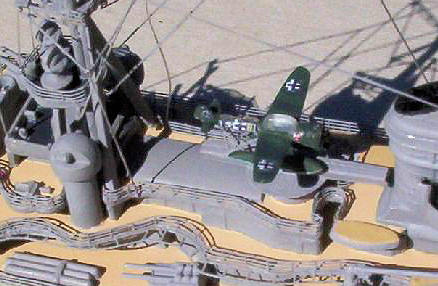 which is
replaced by photoetch from the WEM set. I also cut off the plastic canopy and
replaced that with a clear piece of plastic cut and sanded to shape. To paint
the floatplane I used Humbrol H149 matt dark green and H91 black green for the
upper surfaces. The lower surfaces were painted with H65 aircraft blue. The PE
propeller and machine gun parts were painted matt black.
which is
replaced by photoetch from the WEM set. I also cut off the plastic canopy and
replaced that with a clear piece of plastic cut and sanded to shape. To paint
the floatplane I used Humbrol H149 matt dark green and H91 black green for the
upper surfaces. The lower surfaces were painted with H65 aircraft blue. The PE
propeller and machine gun parts were painted matt black.
After assembly, I then added the rigging using Aeroclub stretch thread. This
detail along with the PE handrails really makes the ship come alive. The last
detail parts, being the 4.1" guns, cranes and boat davits were then added. The
handrails around the perimeter were then added. Unfortunately, there was not
enough rails to go around and I had to buy some more rails from WEM. At long
last, I could remove the tape around the hull. The propellers were painted
bronze and glued on.
For the stand, I attached a strip of plastic card to display the ship's name.
The stand was then painted in satin black. The name was printed using my ALPS
printer in gold ink in Encient German Gothic font. Finally the stand was glued
on followed by the flag pole at the stern. This is a little high and I will make
this shorter. Some touch ups and the model was done!
| CONCLUSIONS |
Although not as detailed and accurate as the Tamiya 1/700 kit, you can still build quite a good model from the Revell kit. The kit also has the option of a full hull, which the Tamiya kit does not offer. I find it amazing the amount of detail that can be packed in this small scale and can see why some modellers are attracted to it. However, I still prefer 1/600 scale as the larger size makes it a little easier to work on and gives a nice size model, compared to the tiny models in 1/700 scale.
| REFERENCES |
http://www.prinzeugen.com/PGIND.htm Prinz Eugen: An illustrated
technical history. A comprehensive site on the ship, including plans which I
used to rig my ship.
http://www.kbismarck.org/forum/viewtopic.php?t=470 A ship history:
Prinz Eugen. Includes very nicely detailed plans in colour of just about every
configuration of the ship. Very useful paint guide.
Steven S Pietrobon
February 2010 If you would like your product reviewed fairly and quickly, please
contact
me or see other details in the
Note to
Contributors.